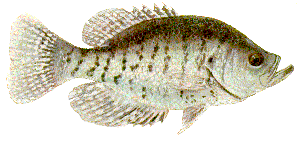White Crappie (Pomoxis annularis)
- Other Names
- White Perch, Sac-a-lait
- Description
- Game fish - see statewide bag & size limits and lake-specific exceptions
Pomoxis is Greek for "opercle sharp" and refers to the fact that the fish's gill covers have spines. The word annularis is Latin for "having rings" and refers to the dark bands (vertical bars) around the body. The white crappie is deep-bodied and silvery in color, ranging from silvery-white on the belly to a silvery-green or even dark green on the back. There are several vertical bars on the sides. The dorsal fin has a maximum of six spines. Males may develop dark coloration in the throat region during the spring spawning season. - Life History
- Like other members of the sunfish family, white crappie are nest builders. They are similar to bluegills in that they tend to nest in relatively large "beds", and they have very high reproductive potential which often leads to overpopulation and stunting in small lakes and impoundments. White crappie nest in the spring, generally when water temperatures reach 65°F to 70°F. However, spawning activity has been observed at temperatures as low as 56°F. Fry hatch in three to five days, but remain attached to nest substrate by an adhesive substance from the egg for a few more days. Just before leaving the nest, fry free themselves by vigorous swimming actions. Once free, they begin feeding on microscopic animals. Although fry do not appear to school, fingerlings do. Schools with large numbers of individuals are often found in the middle of lakes. Typically, white crappie grow three to five inches in length the first year, and reach seven to eight inches during the second year. Maturity is usually reached in two to three years. Adults feed on small fish and insects.
- Distribution
- The native range of white crappie included the area west of the Appalachian Mountains north to southern Ontario and south to the Gulf of Mexico. The range extended west to Minnesota and South Dakota in the north, and to northeastern Mexico in the south. Today the range extends east to the Atlantic coast, and west to include California and portions of Nevada, Arizona, New Mexico, Montana, Colorado, Utah, and North Dakota. White crappie are native to the eastern two-thirds of Texas, but the species can now be found statewide except for the upper portions of the Rio Grande and Pecos drainages.
- Other
- Taken together, "crappie" (white and black combined) is the most popular panfish in Texas. The crappie group is the third most preferred group overall, ranking behind only "bass" and "catfish." Crappie are sought after by both bank and boat anglers. Typically, minnows are the preferred bait, often producing monumental results when an aggregation is located, usually around submerged trees, boat docks, or other submerged structures. White crappie in excess of 4.5 pounds have been landed in Texas waters.
